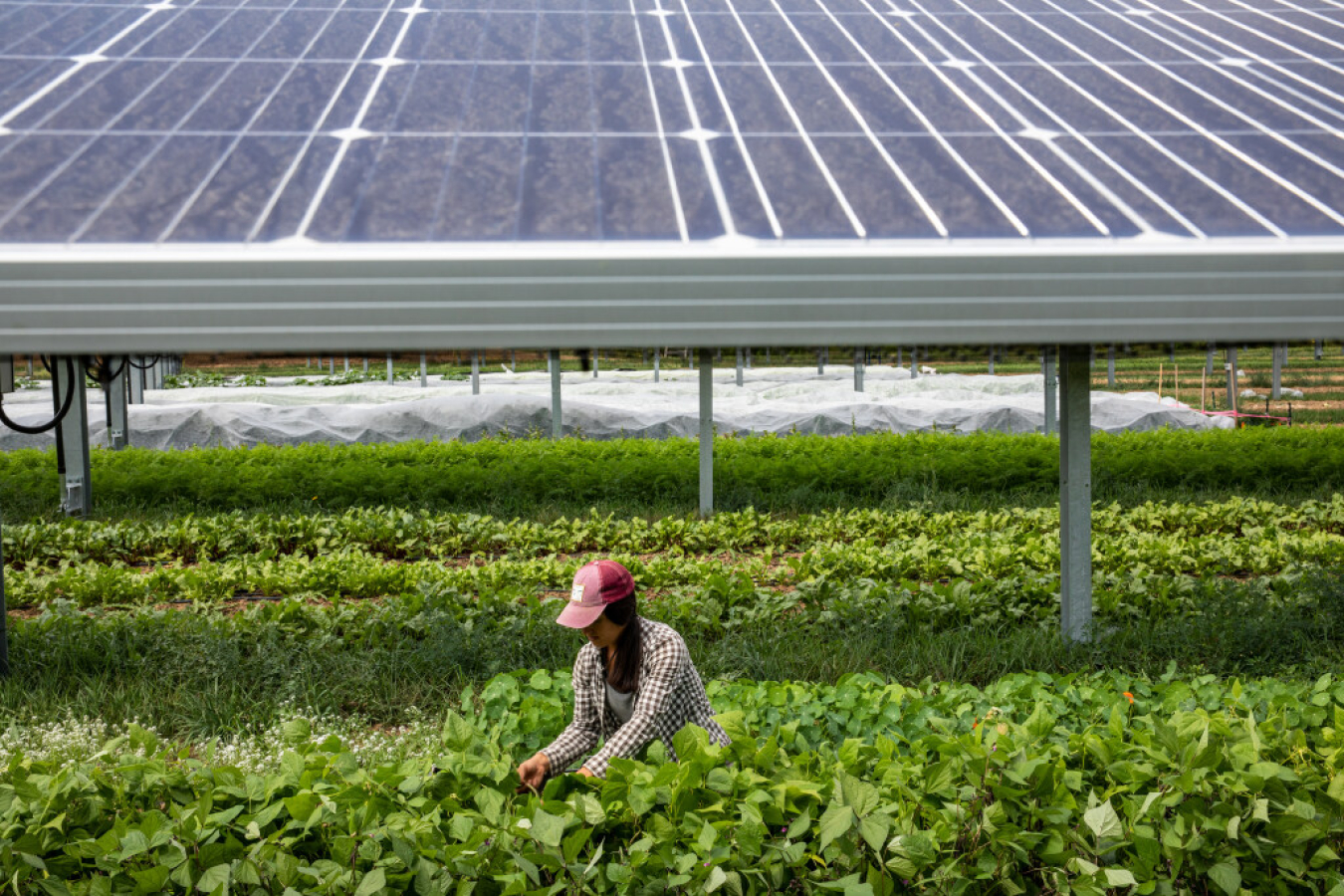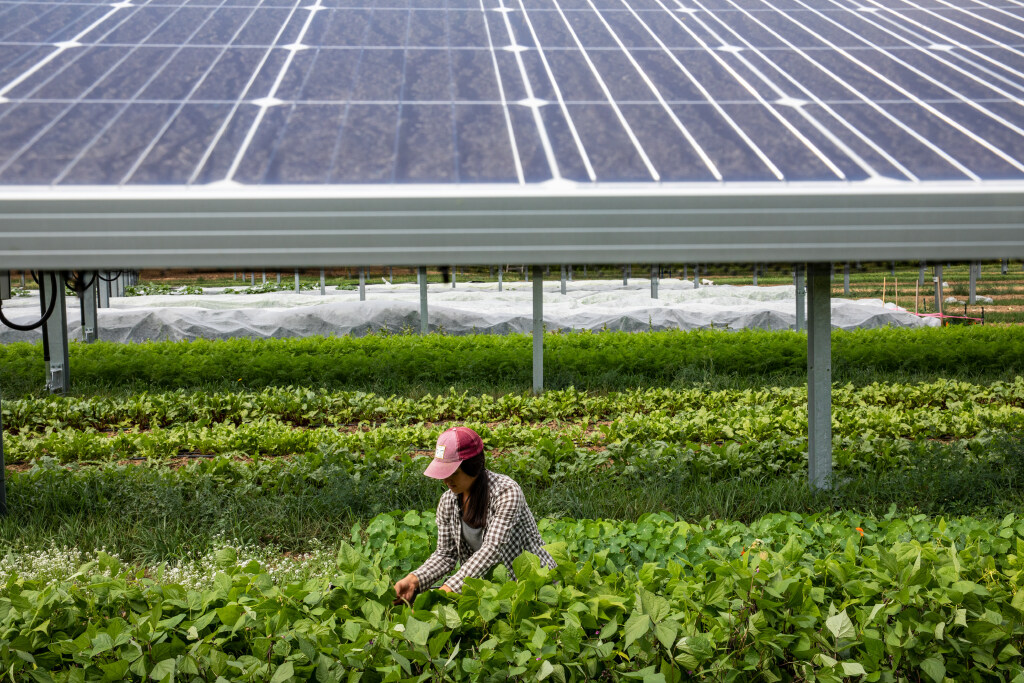
A farmer harvests crops at Jack’s Solar Garden, a 1.2 megawatt community solar garden and agrivoltaics research site in Colorado. Photo by Werner Slocum / National Renewable Energy Laboratory
This blog post was originally published as an article in PV Tech POWER.
Large-scale solar energy installations are a relatively new form of development in many rural areas. Solar energy development can create clean energy, jobs, and other economic benefits in these communities. At the same time, the conversion of agricultural land, which tends to be flat and sunny, to solar energy development can raise local concerns that delay or derail projects. Agrivoltaics – the co-location of solar energy installations and agriculture beneath or between rows of photovoltaic panels – has the potential to help ease this land-use conflict.
To address climate change, the Biden-Harris Administration set a goal to decarbonize the electricity sector by 2035. Solar energy, which currently provides about 4% of U.S. electricity supply, has a key role in this decarbonization. According to the U.S. Department of Energy’s Solar Futures Studysolar energy could supply as much as 40% of U.S. electricity by 2035.
This level of solar deployment could require about 5.7 million acres, or 0.3% of the U.S. contiguous land area. While this is a small percentage of U.S. land, it is in addition to other types of infrastructure development that are also leading to the conversion of farmland. Moreover, large-scale solar energy is not going to be evenly distributed across the landscape, because it must be located near transmission lines. Combining agriculture and solar on the same piece of land might be a solution, which is why DOE is funding $15 million in research on how agrivoltaics could work for farmers, the solar industry, and communities.
Agrivoltaics is still a nascent business model. Based on data collected so far by the National Renewable Energy Laboratory, there are over 2.8 GW of agrivoltaic sites in the U.S., the majority of which involve sheep grazing and/or pollinator habitat. Growing crops under solar panels has been largely confined to research test plots, though this is beginning to change. At least five commercial solar-crop sites are operating in Colorado, Massachusetts, and Maine.
A few states are encouraging the construction of agrivoltaics through incentives or research. Massachusetts has enacted a feed-in tariff adder of $0.06/kWh for agrivoltaic projects through its Solar Massachusetts Renewable Target (SMART) program. New Jersey authorized an agrivoltaics pilot program of up to 200 MW on unpreserved farmland and funded an R&D system at the Rutgers New Jersey Agricultural Experiment Station. Colorado has also funded agrivoltaics research.
Agrivoltaics has the potential to help farmers adapt to climate change and diversify their income through land lease payments or other business structures. Research in the drylands of Arizona found that farming under solar panels can decrease evaporation of water from the soil and potentially reduce irrigation requirements. Agrivoltaics can also improve crop yield and crop resistance in extreme weather, such as droughts. Adding farming to existing solar energy sites is being explored as an approach to increase access to land for historically disadvantaged groups, such as Black and immigrant farmers. At the same time, questions remain for farmers about how to do agrivoltaics, including which crops are suitable in a shaded environment.
For the solar industry, agrivoltaics has the potential to facilitate siting of solar installations, improve solar PV panel performance by cooling the panels, and lower operations and maintenance costs by limiting the need for mowing. Yet the capital costs of agrivoltaics tend to be higher than traditional solar development due to modified system structures and more complex design and installation. To make agrivoltaics a widely available option for developers, questions about cost, worker safety, liability, and other business, legal, and regulatory issues will need to be addressed.
For communities, agrivoltaics could help keep farmland in production – and help sustain rural farmland economies. More research is needed, however, to understand whether – and under what conditions – communities are likely to support solar development if it combines both energy and agriculture.
All agrivoltaic stakeholder groups – from developers to farmers to financiers and insurers – will need to understand each other’s priorities and establish common goals to realize the potential benefits. Communities will need to see tangible benefits from agrivoltaics.
To help bring agrivoltaics to maturity, DOE’s research is examining how agrivoltaics can impact both agriculture and energy production and how agrivoltaics can fit into agricultural communities and economies, including public perceptions. Our projects, like the AgriSolar Clearinghouse, are providing technical assistance and developing resources to lower the barrier of entry for agricultural producers and solar developers. We are collaborating with the U.S. Department of Agriculture on foundational research to help understand the economic value and tradeoffs and ecological impacts of agrivoltaics projects. DOE is also funding the development of new technologies that could facilitate agrivoltaics and help lower the cost premium.
Agrivoltaics is not a panacea for all farmland conservation or solar development needs, but it is a potential tool in the toolbox for meeting our climate goals, supporting farmers by keeping farmland in production, and supporting the economies of rural communities.
Learn more about agrivoltaics research funded by the U.S. Department of Energy Solar Energy Technologies Office.


